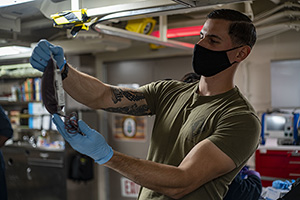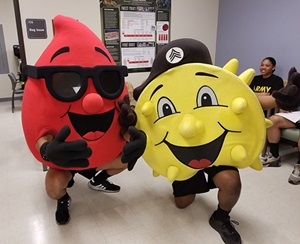The ASBP is a program comprised of dedicated men and women, service members, family members, retirees, veterans, federal employees, and others with a commitment to saving lives worldwide.
Our donors are the heart of our program. Without donors taking the time to come in and donate and on a regular basis, the ASBP cannot stand ready for our mission of supporting military health care operations worldwide with a steady supply of quality blood products.
Your interest in donating for our military community is appreciated.
Since 1952, the ASBP has provided more than 1.5 million units of blood to treat battlefield illnesses and injuries.
How Your Donation Helps Save Lives

Blood is a fascinating substance. It rejuvenates itself while also carrying oxygen and nutrients throughout the body. It can be donated and the body will still have plenty. It’s a helper and a healer.
A blood donation, whether in the form of whole blood, platelets, or plasma, can be thought of as a medical treatment just like medicine. It helps the burn victim heal tissue, the cancer patient combat diseased cells, and the trauma victim stay alive. To learn more about what your blood is made up of, why there are different types, and what your blood type can do for others, visit our About Blood page.
Ready To Donate?
Did you know that of the 38% of individuals in the U.S. that are eligible to donate, only 3% do? The ASBP is hoping you can help change that percentage. Donating on a frequent basis can make blood shortages become a thing of the past. Every type is needed. Every blood product is needed.
Are you thinking about giving a standard donation (whole blood) or even an apheresis donation (platelets, plasma, or red cells)? Consider looking into how each of these are used and what eligibility is required. Visit our About Blood page to find out more.
Blood product safety is always a top concern. Therefore, the FDA sets requirements to keep blood safe and regulates blood program organizations, including the ASBP. Because of these requirements, not everyone can donate. Some requirements for donating only defer an individual temporarily, while others may be indefinite.
Basic eligibility and common deferrals, both dealing with medical or travel, can be found on our Can I Donate page.
Let's Save Lives!

Below is what to generally expect and be aware of prior, during, and after your donation experience.
Now that you’re ready to donate, looked over basic eligibility and deferrals, and are feeling great, you can visit our page of donor centers, email us directly, or go to our registration and drive locator site and do a quick zip code search for an ASBP drive or center nearest you!
Your donation will make an IMMEDIATE impact on a service member, their family, a retiree, or a veteran in need. Welcome to the lifesaving family!
STEP 1: Before Your Donation
- Get plenty of sleep the night before you plan to donate.
- Eat a healthy meal before your donation. Avoid fatty foods, such as a hamburger, fries, or ice cream.
- Drink plenty of water before the donation.
- Check to see if any medications you are taking or recently took would prevent you from donating. For example, if you are a platelet donor, you must not take aspirin for two days prior to donating. Talk to your doctor before discontinuing any medications.
STEP 2: At Your Donation | Donation Process
- You will complete a series of donor questions, including your name, address, phone number, etc. You will be asked a few questions about your health.
- You will receive a mini-physical to ensure that you are healthy enough to donate blood. This includes checking your temperature, blood pressure, pulse, and iron level.
- You will be asked to recline in a donor chair and one of our phlebotomists will prepare your arm, sanitizing it, and asking you to squeeze your fist to increase blood circulation. Sterile, disposable, one-use-only supplies are used for your donation. Once blood collection is started, it typically takes about 20 minutes to donate one unit (about a pint).
- Now you’ve earned a snack! We encourage you to relax in our refreshment area and enjoy some juice and cookies to replenish your body before you take on the rest of your day.
STEP 3: After Your Donation Guidance
After donating, you will be directed to a refreshment area, where you rest and eat a light snack. After 15 minutes, you can leave if you are feeling just fine.
After your blood donation:
- Drink extra fluids.
- Avoid strenuous physical activity or heavy lifting for about five hours.
- If you feel lightheaded, lie down with your feet up until the feeling passes.
- Keep your bandage on and dry for the next five hours.
- If you have bleeding after removing the bandage, put pressure on the site and raise your arm until the bleeding stops.
- If bruising occurs, apply a cold pack to the area periodically during the first 24 hours.
- Consider adding iron-rich foods to your diet to replace the iron lost with blood donation.
Contact the blood donor center or your doctor if you:
- Forgot to report any important health information.
- Have signs and symptoms of an illness, such as a fever, within several days after your blood donation.
- Are diagnosed with COVID-19 within 48 hours after donating blood.